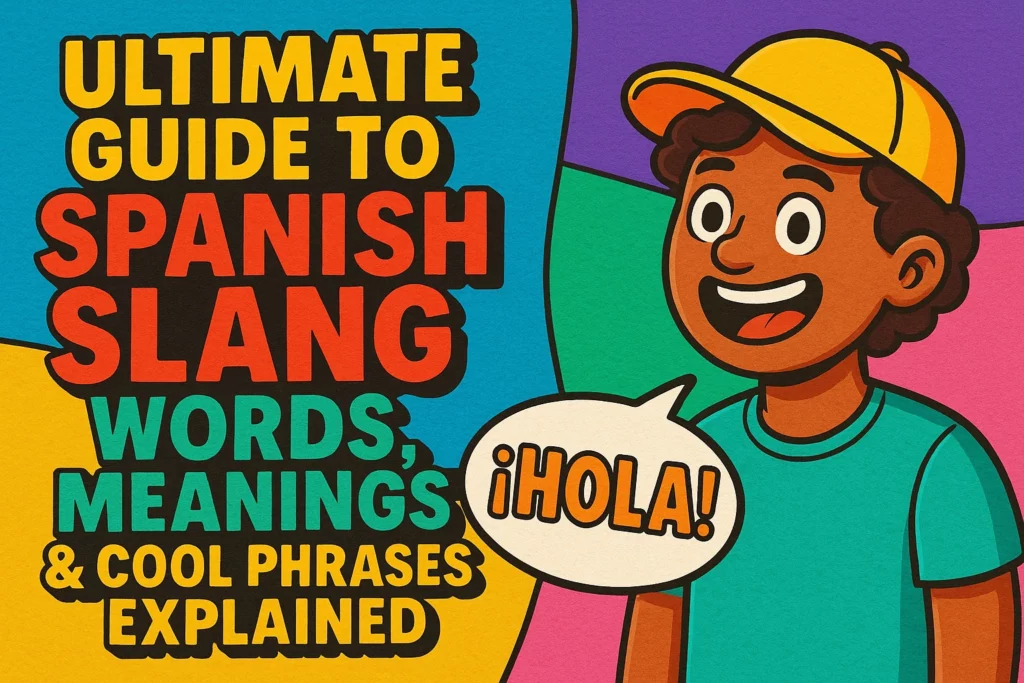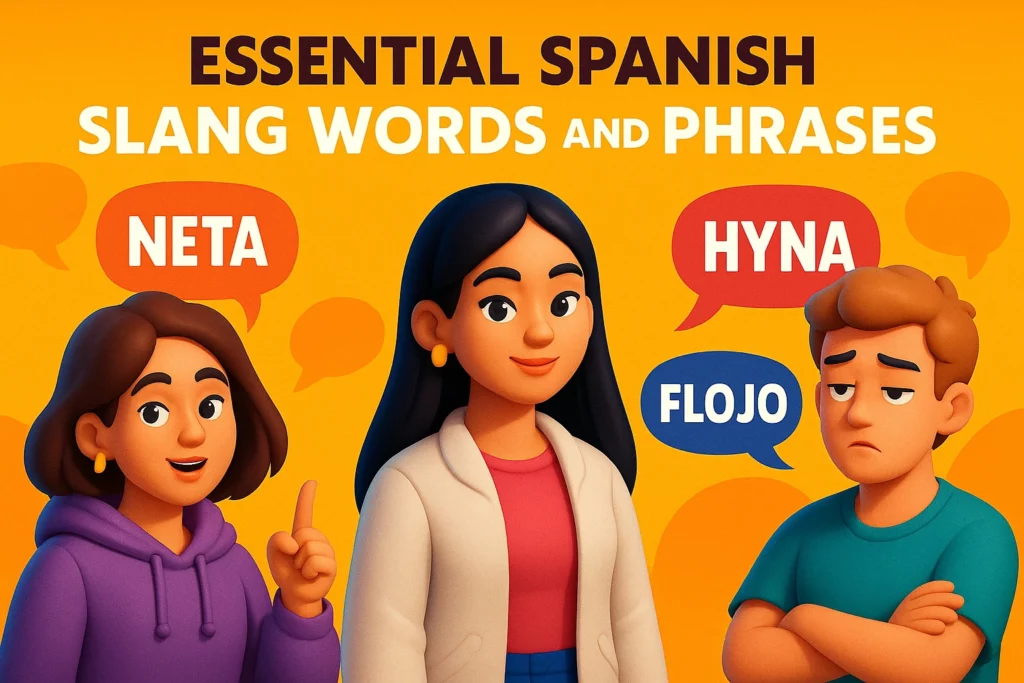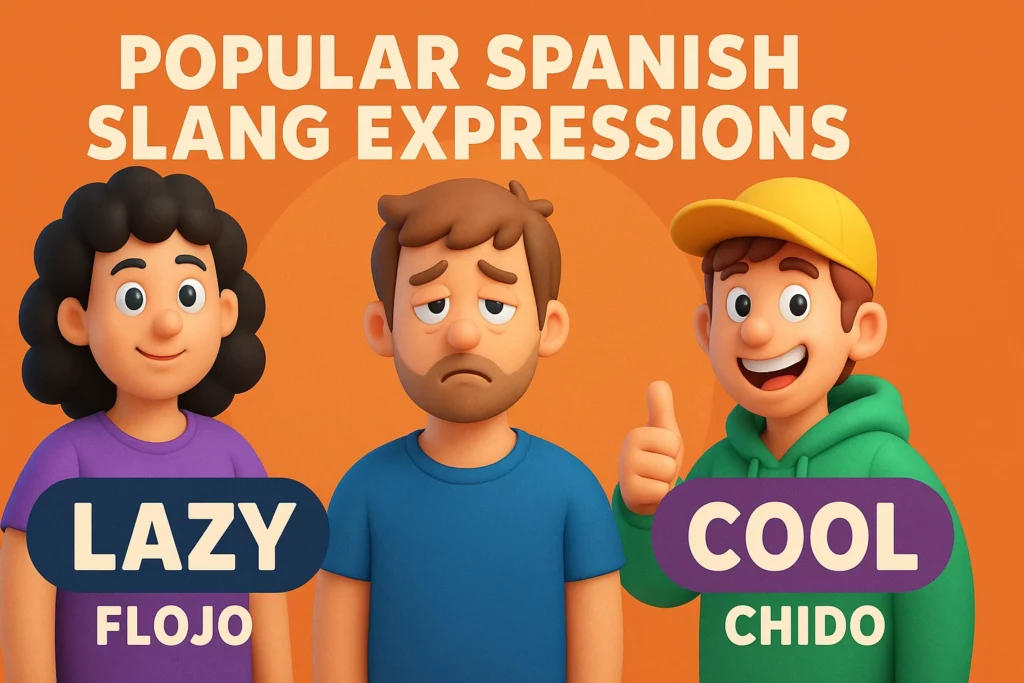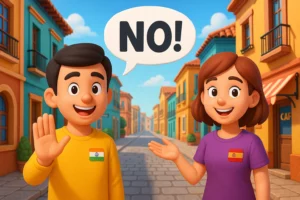
When you start learning Spanish, you quickly realize that knowing textbook grammar or formal vocabulary is just the beginning. If your goal is to truly understand native speakers and communicate naturally, mastering Spanish slang is essential.
Spanish slang words offer a unique window into the culture, humor, and everyday lives of native speakers across different Spanish-speaking countries. Unlike formal language, slang evolves quickly, reflecting social changes, trends, and cultural influences.
For instance, you might hear someone using words like “neta,” a popular slang term in Mexico meaning “truth” or “really,” or describing something impressive as “cool in Spanish slang” with words like “chido” or “guay,” depending on the region.
However, understanding slang isn’t just about sounding more natural—it also helps you avoid embarrassing misunderstandings. Consider terms like “punta in Spanish slang,” frequently confused with the offensive term “puta.” Knowing the difference can save you from awkward situations.
In this comprehensive guide, you’ll not only learn the meanings of popular slang expressions like “lazy in Spanish slang” (“flojo,” “huevón”), “hyna Spanish slang,” and more, but you’ll also understand when and how to use them appropriately.
We’ll even help you start building your own personal Spanish slang dictionary for quick reference.
Ready to speak Spanish like a true local? Let’s dive in!
What is Spanish Slang?
When diving deeper into the Spanish language, you’ll quickly come across the vibrant world of Spanish slang. But what exactly does this mean? Let’s explore.
The Definition of Spanish Slang
Simply put, Spanish slang refers to informal, casual, or colloquial words and expressions commonly used by native Spanish speakers. Unlike formal Spanish—which you might learn in textbooks or classrooms—slang includes words and phrases that evolve organically within communities and reflect local culture, humor, and even social identity.
These Spanish slang words are typically specific to particular regions or countries, giving you a glimpse into the local customs, lifestyle, and societal trends.
Historical Background and Evolution
Slang isn’t a new phenomenon, it’s been a natural part of language evolution for centuries. As societies interact, cultures blend, and new technologies emerge, slang continuously adapts. The Spanish language itself has absorbed indigenous terms, English loanwords, and internet-driven expressions, resulting in unique and region-specific slang.
For example, Mexican Spanish includes words like “neta”, meaning “truth” or “really,” which originated from regional usage but has spread across many Spanish-speaking communities due to media and pop culture influences.
Similarly, Chicano Spanish—spoken among Mexican-American communities in the USA—has introduced slang such as “hyna,” referring to a girlfriend or attractive girl, which reflects the blending of Spanish with local cultural elements.
Formal Spanish vs. Slang: What’s the Difference?
While formal Spanish adheres strictly to grammar rules, slang often breaks conventional grammar norms and can be difficult to translate literally. For instance, the word for “lazy in Spanish slang” differs widely by country—terms like “flojo,” “huevón,” or “vago” are common and may carry varying degrees of offensiveness depending on context.
Likewise, the word for “cool in Spanish slang” has multiple variations—such as “chido” in Mexico, “guay” in Spain, and “chévere” in many South American countries—each carrying its own local flavor and nuance.
Additionally, knowing slang terms can help you avoid misunderstandings. For instance, while “punta in Spanish slang” simply means “tip” or “point,” it’s often mistakenly confused with the offensive term “puta,” which carries a very different, negative meaning.
Learning and recognizing these differences enhances your Spanish fluency, cultural sensitivity, and communication effectiveness.
Building Your Own Spanish Slang Dictionary
Given the diversity and regional specificity of slang, creating your personal Spanish slang dictionary is a valuable strategy. This personalized dictionary can include slang terms, their meanings, and example sentences you’ve encountered in movies, conversations, music, or online resources.
Keeping track of slang not only improves your practical vocabulary but also deepens your connection to authentic Spanish-speaking culture.
Suggestion: 50+ Best Spanish Songs You Must Listen To Right Now
Essential Spanish Slang Words and Phrases

To effectively communicate in everyday Spanish conversations, knowing popular Spanish slang words is crucial. Below is a comprehensive table of essential slang terms, their English meanings, and practical example sentences to help you quickly grasp their usage:
| Spanish Slang | English Meaning | Example Sentence (Spanish) | Example Translation (English) |
| Neta | Truth / Really | “¿Es neta que ganaste?” | “Is it true that you won?” |
| Hyna | Attractive girl | “Su hyna vino a la fiesta.” | “His girlfriend came to the party.” |
| Flojo/Huevón | Lazy | “Mi hermano es muy flojo.” | “My brother is very lazy.” |
| Chido/Guay | Cool | “Tu ropa está bien chida.” | “Your outfit is really cool.” |
| Güey | Dude, guy | “Oye güey, vamos a salir.” | “Hey dude, let’s go out.” |
| Qué onda | What’s up | “¿Qué onda? ¿Cómo estás?” | “What’s up? How are you?” |
| Carnal | Bro, close friend | “Te veo luego, carnal.” | “See you later, bro.” |
| Mande | What? (Polite) | “¿Mande? No escuché bien.” | “What? I didn’t hear clearly.” |
| Órale | Alright, wow | “¡Órale! Está impresionante.” | “Wow! That’s impressive.” |
| Punta | Tip, point | “Rompí la punta del lápiz.” | “I broke the pencil tip.” |
| Pedo | Problem, drunk | “Tengo un pedo en casa.” | “I have a problem at home.” |
| Vato | Guy | “Ese vato es muy amable.” | “That guy is very friendly.” |
| Chamba | Job, work | “Tengo mucha chamba hoy.” | “I have a lot of work today.” |
| Chela | Beer | “¿Quieres una chela fría?” | “Do you want a cold beer?” |
| Lana | Money | “No tengo mucha lana.” | “I don’t have much money.” |
| Simón | Yes, Sure | “Simón, vamos juntos.” | “Sure, let’s go together.” |
| Fresa | Snobby, posh | “Ella es muy fresa.” | “She is very snobby.” |
| Gringo | Foreigner (usually American) | “El gringo habla bien español.” | “The American speaks Spanish well.” |
These examples will enhance your conversational skills, helping you communicate more naturally and authentically.
Building Your Spanish Slang Dictionary
Now that you’ve familiarized yourself with these popular slang terms, consider compiling your own personalized Spanish slang dictionary. Keeping track of new slang terms, expressions, and example sentences you come across will significantly speed up your Spanish learning journey.
Having your personalized slang dictionary at hand means you’ll always have a quick reference for conversational Spanish, enabling you to confidently connect with native speakers in the USA, Latin America, and Spain.
Commonly Confused Slang Terms: Punta vs. Puta
Navigating the world of Spanish slang can occasionally lead to confusion, especially when similar-sounding words carry drastically different meanings. One of the most frequently misunderstood pairs is “punta” and “puta.” Understanding the difference between these two terms is essential to avoid unintended offense.
Related: Top 10 Best Apps to Learn Spanish Quickly and Effectively
What Does Punta Really Mean?
In Spanish, the word “punta” literally translates to “tip” or “point.” It’s entirely harmless and commonly used in everyday conversations. For instance:
- “La punta del lápiz está rota.” – (“The pencil tip is broken.”)
- “Voy a la punta de la montaña.” – (“I’m going to the tip (peak) of the mountain.”)
However, in some contexts, particularly among non-native speakers, confusion arises due to pronunciation similarities between “punta in Spanish slang” and “puta.”
Why It’s Often Confused With “Puta”?
The confusion primarily stems from the phonetic similarity between “punta” and “puta.” The word “puta” is an offensive term meaning “prostitute” or “whore,” and it’s often used as a general insult or exclamation of frustration. Mispronouncing or mixing these words can quickly lead to embarrassment.
For example:
- Incorrect (offensive): “La puta del lápiz está rota.”
- Meaning: (accidentally offensive due to using “puta”)
- Correct (harmless):“La punta del lápiz está rota.”
- Meaning: (“The pencil tip is broken.”)
By clearly distinguishing between these words, you can communicate more confidently without risking misunderstandings or offending native speakers.
Quick Tip to Avoid Confusion
- Punta → Tip, point (neutral, safe)
- Puta → Highly offensive slang term (avoid casual usage)
When in doubt, slow down your pronunciation, or choose alternative words to ensure clarity and cultural sensitivity.
Popular Spanish Slang Expressions: Lazy and Cool

Understanding how to describe common concepts like “lazy” or “cool” using Spanish slang will instantly make your speech more authentic and relatable. Let’s explore some of the most popular ways these expressions are used across different Spanish-speaking regions.
You May Also Like: Best Way to Learn Spanish Fast and Speak with Confidence
How to say “Lazy” in Spanish Slang?
The word for “lazy in Spanish slang” differs based on the region, but the following terms are widely recognized and commonly used:
- Flojo (general use, mild term)
- Example: “Eres demasiado flojo para trabajar hoy.” – (“You’re too lazy to work today.”)
- Huevón (stronger, informal, mostly used in Mexico and Central America)
- Example: “Mi amigo es bien huevón, nunca quiere hacer nada.” – (“My friend is really lazy; he never wants to do anything.”)
- Vago (common in Spain)
- Example: “No seas vago, ayúdame con la tarea.” – (“Don’t be lazy, help me with the homework.”)
How to say “Cool” in Spanish Slang?
Expressing something as “cool in Spanish slang” also varies widely. Here are the most popular and frequently used terms:
- Chido (Mexico, popular informal slang)
- Example: “Tu camisa está bien chida.” – (“Your shirt is really cool.”)
- Guay (Spain, very common casual slang)
- Example: “Esa película está muy guay.” – (“That movie is very cool.”)
- Chévere (South America, especially Colombia and Venezuela)
- Example: “¡Qué chévere verte aquí!” – (“How cool to see you here!”)
- Bacán (Chile, Peru, Ecuador)
- Example: “Tu nuevo celular está bacán.” – (“Your new cellphone is cool.”)
Using these slang words correctly and appropriately will help you blend in effortlessly in casual conversations, giving your Spanish a more native-like fluency.
Regional Variations and Cultural Context
One fascinating aspect of Spanish slang is how significantly it varies across different regions and communities. Understanding these regional differences can greatly enhance your communication and cultural awareness, whether you’re traveling, studying, or interacting with Spanish-speaking communities.
Spain vs. Latin America
While the core Spanish language remains consistent, slang terms can differ remarkably between Spain and Latin American countries.
Examples of Regional Differences:
| English Meaning | Spain (Slang) | Latin America (Slang) |
| Cool | Guay | Chido, Chévere |
| Dude / Friend | Tío/Tía | Güey, Carnal, Pana |
| Money | Pasta | Lana, Plata |
| Lazy | Vago | Huevón, Flojo |
For instance, while you’d call your friend “tío” (“dude”) in Spain, you’d likely use “güey” or “carnal” in Mexico or “pana” in Venezuela.
Mexican-American Spanish Slang (e.g., Hyna, Neta)
Mexican-American or Chicano Spanish spoken predominantly in the USA is particularly rich with unique slang influenced by both Mexican culture and American English.
Two prime examples are:
Hyna
- Meaning: A girlfriend or attractive woman.
- Usage: “Esa hyna es muy bonita.” (“That girl is very pretty.”)
Neta
- Meaning: Truth, really.
- Usage: “¿Es neta que te mudas?” (“Are you really moving?”)
These slang words reflect the cultural blending within Mexican-American communities, making them particularly meaningful for interactions in the USA.
By acknowledging these variations, you’ll navigate Spanish slang words with greater confidence, sensitivity, and authenticity, effectively connecting with diverse Spanish-speaking communities around the world.
How to Learn and Remember Spanish Slang?
Learning Spanish slang can seem overwhelming at first because it changes frequently and varies by region. However, by following some practical methods, you can easily incorporate slang into your daily vocabulary.
1. Immerse Yourself in Authentic Content
Regularly watch Spanish-language TV shows, films, YouTube videos, or listen to podcasts. Pay close attention to the slang used in casual dialogues.
- Popular series on Netflix like Narcos, Money Heist (La Casa de Papel), or Elite can expose you to slang naturally.
- Spanish-language music from artists like Bad Bunny, Rosalía, or Daddy Yankee often contains trendy slang terms.
2. Engage in Conversations with Native Speakers
Nothing helps you remember slang better than real-world usage. Regularly practice speaking with native speakers either online (via language exchange platforms) or offline (through community meetups).
- Ask your conversation partner about common slang phrases they frequently use.
- Clarify slang terms you encounter and ask about their appropriate usage to avoid misunderstandings (like the confusion between “punta in Spanish slang” and “puta”).
3. Use Flashcards and Note-taking
Whenever you encounter new slang terms, immediately write them down with their English meanings and example sentences. Apps like Anki or Quizlet can help you systematically review and memorize these terms.
Also Check: 12 Real Ways to Say “How Are You” in Spanish: Formal, Informal And Slang Examples
Creating Your Own Spanish Slang Dictionary
One of the best strategies to remember and organize Spanish slang words is by creating your personal Spanish slang dictionary. Here’s how you can easily create one:
- Use a dedicated notebook or digital app to keep track of slang terms.
- Include translations and context: Write rite the slang word, its English meaning, and a sample sentence.
- Categorize by region or topic (for instance, slang from Mexico, Spain, or slang for casual conversations).
- Regularly update your dictionary: As slang evolves, consistently add new terms you encounter.
Example entry for your dictionary:
- Neta (Mexico)
- Meaning: Truth, really.
- Example: “Neta, no lo sabía.” (“Really, I didn’t know that.”)
- Huevón (Latin America)
- Meaning: Lazy
- Example: “Deja de ser huevón y estudia.” (“Stop being lazy and study.”)
By consistently applying these tips, you’ll rapidly boost your confidence and fluency in using slang, significantly enhancing your Spanish conversations.
Frequently Asked Questions about Spanish Slang
What does “neta” mean in Spanish slang?
The neta meaning in Spanish slang is “truth” or “really.” It’s commonly used in Mexico to express sincerity or disbelief.
Example: “¿Neta vas a venir?” (“Are you really coming?”)
Is “punta” offensive in Spanish?
No, the term “punta in Spanish slang” itself isn’t offensive—it simply means “tip” or “point.” However, it’s often confused with “puta,” an offensive term meaning “prostitute” or used as a general insult.
Example (Correct): “La punta del lápiz.” (“The tip of the pencil.”)
How do you say “cool” in Spanish slang?
Common ways to express “cool in Spanish slang” are:
- Chido (Mexico)
- Guay (Spain)
- Chévere (South America)
Example: “Tu carro está muy chido.” (“Your car is very cool.”)
What’s the best way to learn Spanish slang?
The best approach is regular immersion. Watch Spanish shows, listen to music, converse with native speakers, and consistently note new slang in your personal Spanish slang dictionary.
What does “hyna” mean in Spanish slang?
“Hyna” in Spanish slang (common in Mexican-American communities) refers to an attractive girl or girlfriend.
Example: “Mi hermano está con su hyna.” (“My brother is with his girlfriend.”)
Why does slang differ so much between Mexico and Spain?
Slang varies significantly between Mexico and Spain because slang is deeply tied to regional culture, history, and local influences, resulting in diverse Spanish slang words unique to each community.
Useful Resources & References

To further enhance your understanding of Spanish slang and continue building your personal Spanish slang dictionary, here are some reliable resources and references you can use:
Online Dictionaries & Translators:
- SpanishDict: Offers comprehensive translations, example sentences, and explanations of slang and idioms.
- WordReference: Highly recommended for slang terms, regional usage, and user discussions clarifying meanings.
- Urban Dictionary Spanish Section: User-submitted slang entries, especially helpful for trendy and informal expressions.
Websites & Blogs:
- FluentU Spanish Blog: Engaging articles, videos, and real-world usage of popular slang.
- Real Academia Española (RAE): Official Spanish dictionary—best for checking formal definitions and accepted slang.
Mobile Apps for Learning Spanish Slang:
- Duolingo: Great for general Spanish learning and includes colloquial expressions.
- Memrise: User-created courses specifically targeting Spanish slang and informal vocabulary.
- Anki Flashcards: Create your personal flashcard decks to systematically memorize Spanish slang words.
Recommended Spanish Content for Immersion:
- Netflix Series:
- La Casa de Papel (Money Heist) – Spanish slang from Spain.
- Narcos – Rich in Colombian and Mexican slang.
- Club de Cuervos – Popular Mexican slang usage.
- Popular YouTube Channels:
- Easy Spanish – Real street interviews demonstrating authentic slang usage.
- Luisito Comunica – Engaging content with rich Mexican slang.
- Podcasts:
- Duolingo Spanish Podcast: Engaging stories that naturally include slang.
- Coffee Break Spanish: Friendly discussions and practical phrases, including slang.
Regular use of these resources will deepen your authentic Spanish knowledge, making conversations more enjoyable and culturally accurate. Happy slang learning!



